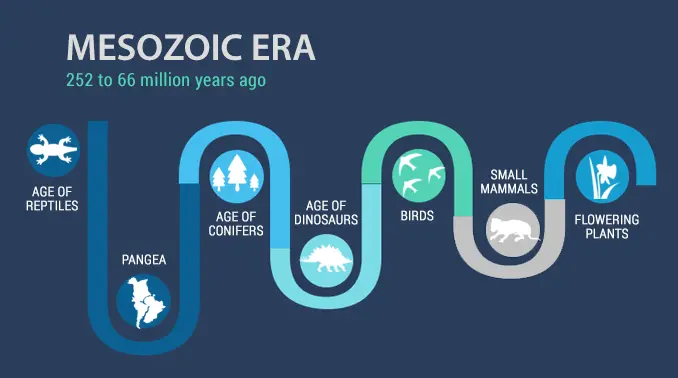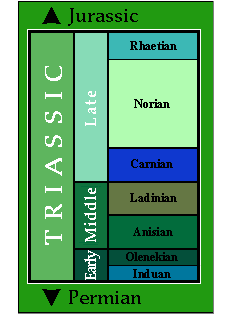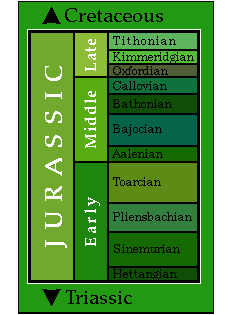Mesozoic Era: The Age of Dinosaurs
Table of Content
Introduction
Triassic Period (approximately 252 to 201 million years ago)
Jurassic Period (approximately 201 to 145 million years ago)
Cretaceous Period (approximately 145 to 66 million years ago)
Life During the Mesozoic Era
Geology of the Mesozoic Era
The Legacy of the Mesozoic Era
Conclusion
Introduction:
The Earth’s history is a captivating story, with each geological era holding its own unique wonders. Among these, the Mesozoic Era stands out as the “Age of Dinosaurs,” a time when massive reptiles ruled the land, skies, and seas.
The Mesozoic Era is one of the three major geological eras of Earth’s history, spanning from approximately 252 million years ago to 66 million years ago. It is often referred to as the “Age of Reptiles” because it was a time when reptiles, particularly dinosaurs, dominated the terrestrial ecosystems. The Mesozoic Era is divided into three distinct periods:


Triassic Period (approximately 252 to 201 million years ago):
This period followed the end-Permian mass extinction, which was one of the most devastating extinction events in Earth’s history. During the Triassic, reptiles diversified, and the first dinosaurs appeared. The landscape was also inhabited by various other reptiles, including early mammals and archosaurs, which are the ancestors of modern crocodiles and birds.

Jurassic Period (approximately 201 to 145 million years ago):
The Jurassic is known for the peak of dinosaur diversity. Many iconic dinosaurs, such as the long-necked sauropods like Brachiosaurus and the carnivorous theropods like Tyrannosaurus rex, lived during this time. Pterosaurs, the first flying reptiles, also evolved during this period. The Jurassic saw the breakup of the supercontinent Pangaea into smaller landmasses.

Cretaceous Period (approximately 145 to 66 million years ago):
The Cretaceous period saw the continuation of dinosaur dominance, including the evolution of feathered dinosaurs and early birds. Flowering plants (angiosperms) diversified during this time, which had a significant impact on terrestrial ecosystems. However, the Mesozoic Era ended with a catastrophic event known as the Cretaceous-Paleogene (K-Pg) mass extinction, which wiped out the non-avian dinosaurs and many other species. It is widely believed that a large asteroid impact in what is now the Yucatan Peninsula of Mexico played a major role in this extinction event.

Life During the Mesozoic Era:
Dinosaurs:
Dinosaurs were the dominant terrestrial vertebrates during the Mesozoic Era. They came in various sizes, shapes, and species. Some iconic dinosaurs from this era include the enormous long-necked sauropods, the ferocious theropods like Tyrannosaurus rex, and the horned and frilled ceratopsians.
Pterosaurs:
Pterosaurs were flying reptiles that ruled the skies during the Mesozoic. They ranged from small, bird-sized creatures to massive, winged giants with wingspans exceeding 30 feet.
Marine Reptiles:
The seas of the Mesozoic were home to a diverse array of marine reptiles. These included ichthyosaurs (resembling dolphins), plesiosaurs (with long necks and paddle-like limbs), and mosasaurs (giant, carnivorous marine lizards).
Mammals:
Although often overshadowed by dinosaurs, early mammals existed during the Mesozoic Era. They were generally small and occupied niches different from the dominant reptiles.
Flora:
The Mesozoic saw the evolution and diversification of plant life. Conifers, cycads, and ferns were common during this time. Additionally, the Cretaceous period witnessed the rise of flowering plants (angiosperms), which eventually became the dominant plant group.
Geology of the Mesozoic Era
Continental Drift:
One of the significant geological events during the Mesozoic was the breakup of the supercontinent Pangaea. This breakup led to the formation of separate landmasses, including Laurasia (northern continents) and Gondwana (southern continents).
Mountain Building:
The movement of tectonic plates and the collision of continents during the Mesozoic led to the formation of mountain ranges. For example, the Rockies in North America began to form during this era.
Seas and Oceans:
The Mesozoic also witnessed changes in the configuration of oceans and seas. Shallow seas covered some regions, which provided habitats for marine life, including various reptiles.
Climate During the Mesozoic Era:
Triassic Period:
The early Mesozoic climate during the Triassic was generally warm, but it became progressively more arid over time. There were periods of volcanic activity and occasional climate fluctuations.
Jurassic Period:
During the Jurassic, the climate was generally warmer and more humid than in the Triassic. The breakup of Pangaea influenced regional climate variations.
Cretaceous Period:
The Cretaceous was characterized by warm, greenhouse-like conditions. There were no polar ice caps during this time, and sea levels were high, leading to the expansion of shallow seas.
Late Cretaceous:
Towards the end of the Mesozoic Era, there were fluctuations in climate, with evidence of cooler intervals, possibly linked to volcanic events and changing ocean circulation patterns.
The Legacy of the Mesozoic Era:
The Mesozoic Era’s legacy is profound and continues to shape our understanding of Earth’s history and evolution. While the non-avian dinosaurs went extinct, their descendants, the birds, thrived and diversified. Mammals, which had been overshadowed by dinosaurs, seized the opportunity to evolve and eventually became the dominant land animals.
Conclusion:
The Mesozoic Era, often referred to as the “Age of Reptiles,” is a testament to the ever-changing story of our planet. Its rich history, characterized by the rise and fall of dinosaurs and the transformation of landscapes, captivates both scientists and enthusiasts alike. By exploring this remarkable era, we gain valuable insights into the Earth’s past and the interconnectedness of life on our planet.